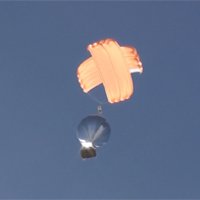


(Reprinted from the JPL Science and Technology website. For the original article, go here.)
On Oct. 15 a team of JPL engineers conducted the first successful aerial deployment and inflation test of their full-scale Venus prototype balloon. The test was conducted at a remote desert area in the Lucerne Valley outside of Los Angeles and mimicked the process and parameters that the team would use for an actual Venus mission.
“A large number of people contributed in ways large and small to make this test successful,” said Jeffery Hall, principal investigator for Venus balloon technology development at JPL. “We’re thrilled that the experiment went so well and that the entire payload landed safely and was recovered without damage.”
The JPL Venus balloon is a superpressure helium balloon designed to suspend a 99 pound (45 kilogram) payload at an altitude of 34 miles (55 kilometers) above the surface of Venus. This is approximately seven times the payload mass carried by each of the two Soviet VEGA balloons that flew at the same altitude at Venus in 1985. At this altitude the Venusian atmosphere has a benign, Earth-like temperature of 86 degrees Fahrenheit (30 degrees Celsius) but also contains clouds formed from sulfuric acid aerosols. Like the Soviet balloons, the JPL Venus balloon uses Teflon-coated materials to survive in that hostile environment.
JPL has been interested in Venus balloon missions for over a decade, with the goal of one day sending such a mission to the planet. The idea of flying new balloons at Venus has also caught the attention of other NASA strategic planners, most recently in the just-completed Venus Flagship Mission Study that includes two helium superpressure balloons in their proposed Design Reference Mission.
For the recent drop test, a helicopter lifted the JPL balloon system to an altitude of 1.5 miles (2.5 km) above the desert. The balloon rig was then detached and descended to the ground via parachute. The packed balloon was deployed from a stowed configuration and then filled with helium gas from high pressure tanks carried onboard the module. For this experiment, the helium tanks remained attached to the balloon; in a real Venus mission, the tanks and parachute would be detached so that the balloon could fly away freely. Nonetheless, the parachute descent speed, balloon diameter (18 feet or 5.5 meters) and the amount of helium gas filling the prototype were all matched to the requirements of a real Venus mission. Hall says the balloon diameter and helium gas requirement will likely grow to accommodate a design upgrade the team is currently undertaking.
The balloon team was particularly gratified to observe that the entire flight train assembly demonstrated remarkable aerodynamic stability, with no indication of undue stresses being applied to the balloon or parachute. “This gives us confidence that the approach will work very well for the actual Venus mission too,” said Hall.
The Venus balloon was fabricated by ILC Dover Inc., based on a design jointly developed by JPL, ILC Dover (which also produces the spacesuits for NASA’s astronauts) and the Wallops Flight Facility at NASA’s Goddard Space Flight Center. The work was made possible through the financial support of the JPL Research and Technology Development (R&TD) program.